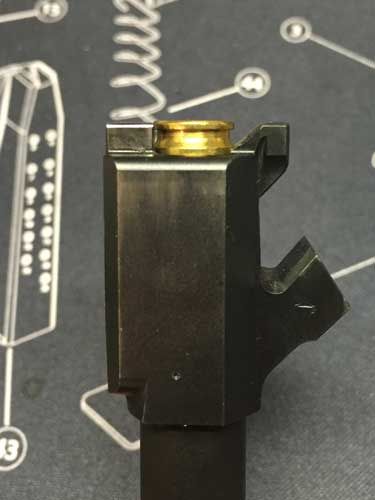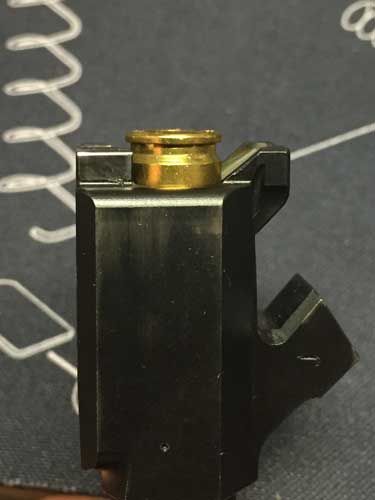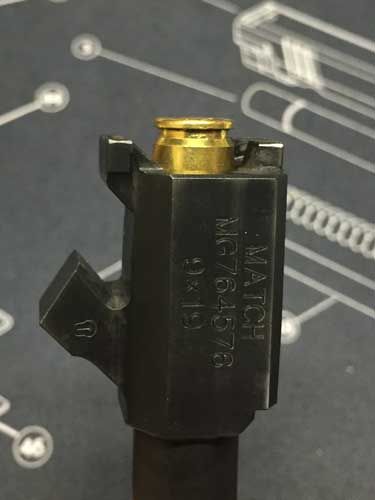All,
Thanks for taking a look and if you have ideas, for your feedback. I'll be as detailed as I can.
I have been reloading for seven years, primarily .45 ACP and .38 Special, adding 9mm in the last few months. Until a month ago, I used a Hornady single-stage press and didn't have this problem. Now I am using a Hornady's LNL AP progressive and encountering a problem I haven't seen before.
My load data:
Brass - mixed
Bullet - 9mm 130 grain coated from Black and Blue Bullets
Primers - Federal Standard Small Pistol
Powder - 5.2 grains HS-6
Setting of COL is set at 1.120", but ranges from 1.115 to 1.133 on actual output
Taper-crimped to 0.375", no crimping with Hornady crimp-seating die
Firearm: Springfield XD(m) 5.25" 9mm
Dies in the press (all Hornady):
I loaded 100 rounds yesterday several wouldn't fire. When they were loaded by the slide into the barrel, they would jam, not entering the barrel all the way. I would have to hold the slide with my left hand, and slam the grip with my right hand as hard as I could to dislodge and eject those rounds. (I only did this three times before I stopped.)
I took the barrel out of the pistol and checked the rounds, and noticed that the ones that wouldn't fire didn't seat completely into the barrel. Going through the rounds I still hadn't fired of the 100, almost 20 wouldn't seat in the barrel, apparently bulging.
Back at my bench, I checked sizing of these rounds. Here is what I found:
Rounds that WOULD fire
Rounds that WOULDN'T load
I pulled the bullets on the bad loads and measured these at the base, but they didn't differ from the bullets that would load, running .356" or .357".
Here is the image of what the rounds looked like that worked:

Here are some images of three of the bad loads:



So, to sum it up, I am baffled as to why these are bulged. They all went completely into the sizing die (at least that is my assumption) and I haven't ever had this problem with my single-stage press. Please note that I am not blaming it on the AP press, but just want to figure this out.
Thanks for any ideas,
Tony C.
Newberg, OR
Thanks for taking a look and if you have ideas, for your feedback. I'll be as detailed as I can.
I have been reloading for seven years, primarily .45 ACP and .38 Special, adding 9mm in the last few months. Until a month ago, I used a Hornady single-stage press and didn't have this problem. Now I am using a Hornady's LNL AP progressive and encountering a problem I haven't seen before.
My load data:
Brass - mixed
Bullet - 9mm 130 grain coated from Black and Blue Bullets
Primers - Federal Standard Small Pistol
Powder - 5.2 grains HS-6
Setting of COL is set at 1.120", but ranges from 1.115 to 1.133 on actual output
Taper-crimped to 0.375", no crimping with Hornady crimp-seating die
Firearm: Springfield XD(m) 5.25" 9mm
Dies in the press (all Hornady):
- Sizing Die
- Expander Die
- Powder Drop
- Seating Die
- Taper Crimp Die
I loaded 100 rounds yesterday several wouldn't fire. When they were loaded by the slide into the barrel, they would jam, not entering the barrel all the way. I would have to hold the slide with my left hand, and slam the grip with my right hand as hard as I could to dislodge and eject those rounds. (I only did this three times before I stopped.)
I took the barrel out of the pistol and checked the rounds, and noticed that the ones that wouldn't fire didn't seat completely into the barrel. Going through the rounds I still hadn't fired of the 100, almost 20 wouldn't seat in the barrel, apparently bulging.
Back at my bench, I checked sizing of these rounds. Here is what I found:
Rounds that WOULD fire
- OAL varied from 1.116" to 1.131"
- Width of the casing at its largest ranged from .387" to 3.89"
Rounds that WOULDN'T load
- OAL varied from 1.127" to 1.134"
- Width of the casing at its largest ranged from .389" to .397" with most between .389" to .393"
I pulled the bullets on the bad loads and measured these at the base, but they didn't differ from the bullets that would load, running .356" or .357".
Here is the image of what the rounds looked like that worked:

Here are some images of three of the bad loads:



So, to sum it up, I am baffled as to why these are bulged. They all went completely into the sizing die (at least that is my assumption) and I haven't ever had this problem with my single-stage press. Please note that I am not blaming it on the AP press, but just want to figure this out.
Thanks for any ideas,
Tony C.
Newberg, OR
Last edited:
